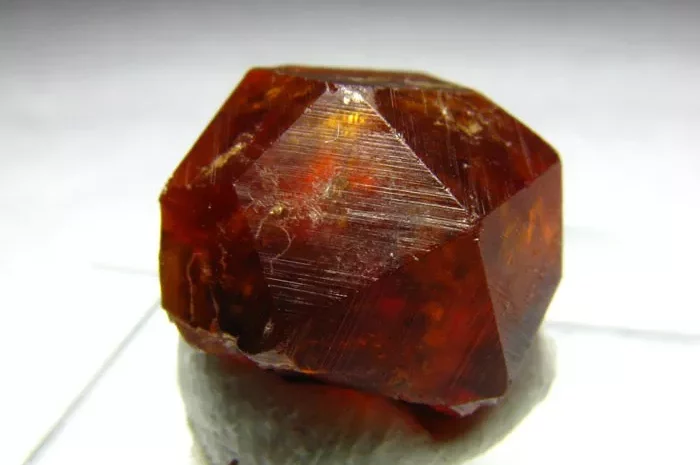Rhodolite garnet, with its captivating rose-red to purplish hue, stands out as a unique and beautiful member of the garnet family. Its discovery marked a significant moment in gemology, adding a new dimension to the already diverse world of garnets. This article delves into the history of rhodolite garnet’s discovery, its distinguishing characteristics, and its impact on the gemological world.
The Garnet Family
Garnets are a group of silicate minerals that have been used as gemstones and abrasives since the Bronze Age. They are known for their wide range of colors and excellent hardness. The most common types include almandine, pyrope, spessartine, grossular, and andradite. Rhodolite is a variety that belongs primarily to the pyrope-almandine solid solution series.
Discovery of Rhodolite Garnet
The Early Days of Garnet Discovery
Garnets have been known to humanity for thousands of years, often associated with protective powers and used in various forms of jewelry. However, the identification and classification of different garnet varieties, including rhodolite, occurred much later as mineralogy developed as a science.
The Role of George Frederick Kunz
The discovery of rhodolite garnet is attributed to George Frederick Kunz, a renowned American mineralogist and gemologist. Kunz, born in 1856, was a prominent figure in the gemological community and worked for Tiffany & Co. as a gemstone expert. His contributions to the field were substantial, and his discoveries helped shape modern gemology.
The Exact Moment of Discovery
While the exact year of rhodolite’s discovery is somewhat obscure, it is generally accepted that Kunz identified this garnet variety in the late 19th to early 20th century. The name “rhodolite” was derived from the Greek word “rhodon,” meaning rose, reflecting its distinctive rose-like color.
Characteristics of Rhodolite Garnet
Color and Composition
Rhodolite garnet is renowned for its striking color, which ranges from light to dark purplish-red, often with hints of pink or violet. This coloration is due to its chemical composition, which is a mixture of pyrope and almandine garnets. The ratio of these two minerals can vary, leading to slight differences in hue and intensity.
Physical Properties
Rhodolite garnet, like other garnets, has a Mohs hardness of 7 to 7.5, making it suitable for various types of jewelry. It has a high refractive index, contributing to its brilliant luster and sparkle. Additionally, it exhibits no cleavage, which means it can be cut and polished without the risk of breaking along defined planes.
The Impact of Rhodolite Garnet’s Discovery
Influence on Jewelry and Fashion
The discovery of rhodolite garnet had a significant impact on the jewelry industry. Its vibrant color and excellent clarity made it a popular choice for various types of jewelry, including rings, necklaces, and earrings. Its affordability compared to other gemstones like rubies and sapphires also contributed to its popularity.
Scientific Significance
From a scientific perspective, the identification of rhodolite garnet added to the understanding of garnet group minerals. It provided insights into the complex chemistry and formation processes of garnets, contributing to broader mineralogical knowledge.
Rhodolite Garnet in Modern Times
Current Sources and Mining
Today, rhodolite garnet is sourced from various locations around the world. Major deposits are found in countries like Tanzania, Mozambique, Sri Lanka, and the United States. These regions produce high-quality rhodolite garnets that are highly sought after in the gemstone market.
Rhodolite Garnet in Gemology
Rhodolite garnet remains a staple in gemological studies. Its distinct properties make it a subject of interest for researchers and gemologists. Advances in gemological tools and techniques continue to provide deeper insights into its structure and characteristics.
How to Identify Rhodolite Garnet
Visual Inspection
Identifying rhodolite garnet primarily involves examining its color. The rose-red to purplish hues are distinctive, but due to overlaps with other garnet varieties, further analysis is often necessary.
Gemological Tools
Gemologists use various tools to accurately identify rhodolite garnet. These include:
Refractometer: Measures the refractive index of the gemstone.
Spectroscope: Analyzes the absorption spectrum to identify specific elements.
Microscope: Examines inclusions and internal features.
Specific Gravity Test: Determines the density of the gemstone.
See Also: Who Should Wear Rhodolite Garnet?
Caring for Rhodolite Garnet
Cleaning
Rhodolite garnet should be cleaned with warm, soapy water and a soft brush. Avoid using harsh chemicals or ultrasonic cleaners, as these can damage the stone.
Storage
Store rhodolite garnet jewelry separately from other pieces to prevent scratches. Using soft pouches or lined jewelry boxes is recommended.
Conclusion
Rhodolite garnet’s discovery, attributed to George Frederick Kunz in the late 19th to early 20th century, marked a notable moment in gemological history. Its unique color, excellent physical properties, and affordability have made it a popular choice in the jewelry industry. The ongoing study and appreciation of rhodolite garnet continue to highlight its significance in both the scientific and commercial realms of gemology.


